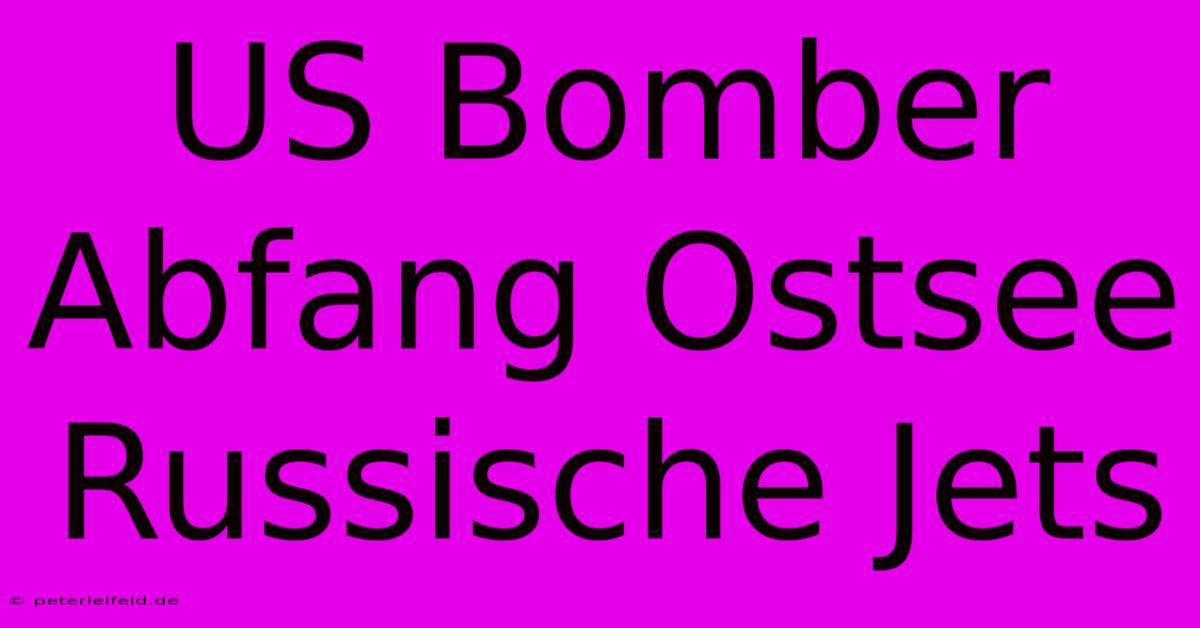US Bomber Abfang Ostsee Russische Jets

Discover more detailed and exciting information on our website. Click the link below to start your adventure: Visit Best Website US Bomber Abfang Ostsee Russische Jets. Don't miss out!
Table of Contents
US Bomber Abfang Ostsee: Russische Jets – A Tense Situation Explained
Hey everyone, so, I've been following this whole US bomber intercept thing over the Baltic Sea pretty closely, and honestly, it's given me major anxiety. These incidents, involving Russian jets intercepting American bombers, are becoming increasingly frequent. It's a seriously tense situation, and I wanted to share my thoughts and what I've learned, because understanding this stuff is crucial.
Understanding the Baltic Sea Context
The Baltic Sea itself is a pretty small body of water, geographically speaking. It's surrounded by a bunch of NATO and non-NATO countries, making it a very strategically important area. Think about it: Russia's got a huge chunk of coastline there, and NATO countries like Poland, Lithuania, Latvia, and Estonia are right on the other side. That's a recipe for potential conflict, you know? It's a region with a long and complex history, full of political tensions and military posturing. This makes it a hotbed for these kinds of incidents.
My Initial Reaction and Misconceptions
When I first heard about these intercepts, I'll admit, I was pretty naive. I pictured these dramatic Hollywood-style chase scenes. Like, fighter jets screaming through the skies, narrowly avoiding collisions. Boy, was I wrong. The reality is far more nuanced and frankly, more concerning.
I thought these intercepts were always reckless, aggressive actions by the Russians. But, from what I've since researched, it's actually more complicated than that. Both sides have different perspectives and interpretations of what constitutes a "safe" distance and appropriate behavior. There's a real lack of clarity on international rules of engagement in this kind of situation.
What We Know About the Intercepts
These intercepts usually involve US Air Force bombers, often B-52s or B-1Bs, conducting training flights near Russian airspace. The Russian Air Force then scrambles jets—often Su-27s or MiG-31s—to intercept these bombers. The concern is that these intercepts can be unsafe, with Russian jets flying very close to the US aircraft. There have been instances where the maneuvers are described as unprofessional or even dangerous, causing concerns about a potential mid-air collision.
This isn't just some game of chicken, though. These actions are important signals sent between nations. They show off military strength and test the limits of air space boundaries. The US views them as aggressive acts of intimidation, threatening peace and stability. On the other hand, Russia likely sees the US flights as provocative and views its own actions as necessary to protect its airspace. So yeah, pretty intense stuff.
Actionable Insights and What You Can Do
It's tricky to get objective, unbiased information about these events. Both sides are going to present their version of the story in a way that favors their narrative. To get a better grasp on what's happening, you really need to consume news from multiple sources. Look for reporting from reputable news organizations, and try to compare their accounts.
Here's what I've learned:
- Be aware of your own biases: We all have them. Try to be critical of information, and seek out diverse perspectives.
- Look beyond the headlines: Dig deeper into the details of these incidents. Look for official statements, and try to understand the context.
- Stay informed: This is an ongoing situation. Keeping up to date on developments will help you better understand the complexities of international relations.
This whole situation over the Baltic Sea is a serious reminder of how fragile peace can be, and how easily misunderstandings can escalate. Let's stay informed and hope cooler heads prevail. It's freaking me out a bit, and I want to do what I can to understand it better. What are your thoughts on all of this? Let's chat in the comments.

Thank you for visiting our website wich cover about US Bomber Abfang Ostsee Russische Jets. We hope the information provided has been useful to you. Feel free to contact us if you have any questions or need further assistance. See you next time and dont miss to bookmark.
Featured Posts
-
Champions League Real Star Verpasst Elfmeter
Nov 28, 2024
-
Champions League Bvb Gewinnt Trotzdem Aerger
Nov 28, 2024
-
Nahe Russland Us Jets Ueben
Nov 28, 2024
-
B52 Flug Ostsee Russische Reaktion
Nov 28, 2024
-
Telekom Aktie Ein Jahr Im Dax 40
Nov 28, 2024
